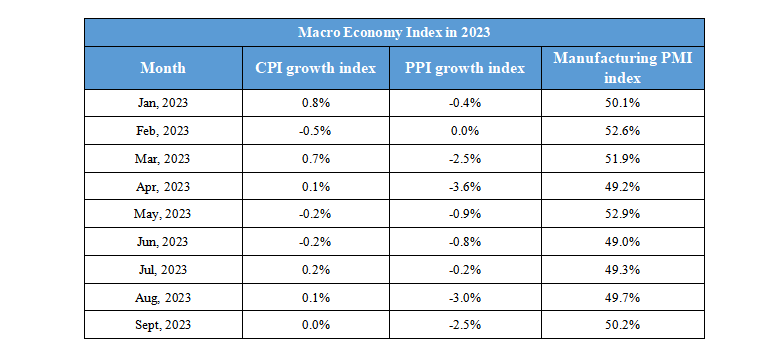November 13th Macroeconomic Index: Sino-US Economic Working Group Meets, 13 Provinces' GDP Growth Exceeds National Average
Daily Macro Economy News
Latest Global Major Index

International Crude Price Trend and Exchange Rate of RMB to USD Trend

Domestic News
1. The Sino-US Economy Working Group held the first meeting
2. The GDP of 21 provinces in the first three quarters was released: the growth rate of 13 provinces exceeded that of the whole country, and the growth rate of 6 provinces was faster than that of the first half of the year
3. In the first three quarters, Zhejiang's electricity consumption increased by 5.83%, and soared by 15% in September
4. Three-dimensional decoding of "flowing" big data: the "pulse" of the economy is enhanced
International News
1. The International Energy Agency expects global oil demand to peak within a decade
2. The German Bundesbank report shows that the German economy continued to be sluggish in the third quarter of this year
3. For the first time in history, Russia's foreign debt to GDP ratio is below 15%
4. US GDP would be boosted by trade in the third quarter as exports increase
Domestic News
1. The Sino-US Economy Working Group held the first meeting
According to news from the website of the Ministry of Finance, according to the consensus reached by He Lifeng, the Vice Premier of the State Council and the Chinese leader of China-US economy and trade, and US Secretary of the Treasury Janet Yellen during the talks in Beijing in July, the first meeting of the Sino-US Economy Working Group was held online on October 24. The meeting was chaired by officials at the level of Vice Ministers of Finance of the two countries. The two sides had in-depth, candid and constructive exchanges on issues such as the macroeconomic situation and policies of the two countries and the world, bilateral economic relations, and cooperation in addressing global challenges. The Chinese side expressed its concerns. The two sides will continue to maintain communication.
2. The GDP of 21 provinces in the first three quarters was released: the growth rate of 13 provinces exceeded that of the whole country, and the growth rate of 6 provinces was faster than that of the first half of the year
According to incomplete statistics, up to now, 21 provinces, autonomous regions and municipalities have released GDP and other related data for the first three quarters, and more than half of the provinces have released the economic "three quarterly reports". Compared with the national level, 13 among them have showed a faster growth rate, and the rank was as follow: Hainan (9.5%), Inner Mongolia (7.2%), Gansu (6.6%), Sichuan (6.5%), Ningxia (6.4%), Zhejiang (6.3%), Anhui (6.1%), Shandong (6.0%), Hubei (6.0%), Shanghai (6.0%), Chongqing (5.6%), Qinghai (5.6%), and Liaoning (5.3%). At present, Hainan has the highest growth rate, followed by Inner Mongolia.
3. In the first three quarters, Zhejiang's electricity consumption increased by 5.83%, and soared by 15% in September
In the first three quarters of this year, the province's cumulative electricity consumption was 462.7 billion kWh, a year-on-year increase of 5.83%. Among them, the electricity consumption of the whole society in September was 55.771 billion kWh, an increase of 15.39%, 5.4 percentage points higher than the national average growth rate. At the beginning of this year, affected by multiple factors, Zhejiang's electricity consumption fell sharply, and then rebounded and circuitously rose, and by the end of June, the electricity consumption of the three major industries all grew positively, and this trend has been maintained so far. In terms of industries, the electricity consumption of the primary industry in the first three quarters was 2.56 billion kWh, an increase of 12.73%; the electricity consumption of the secondary industry was 308.19 billion kWh, an increase of 6.5%; The electricity consumption of the tertiary industry was 81.66 billion kWh, an increase of 10.08%.
4. Three-dimensional decoding of "flowing" big data: the "pulse" of the economy is enhanced
On October 23, China's 100 billion express delivery was sent this year, 39 days earlier than last year; In the first nine months, the national railways held a total of 2.897 billion tons of goods, and goods transportation remained at a high level. And in the third quarter, the national railways held 1.15 billion passengers, an increase of 11.6% over the same period in 2019. People enjoy their walk and goods flow freely. The "flowing" big data highlights the vitality of the economic "pulse", and the three-dimensional flow of passenger flow, logistics and capital flow reflects the accelerated release of China's consumer demand, and the pace of economic recovery is accelerating.
International News
1. The International Energy Agency expects global oil demand to peak within a decade
For the first time, the International Energy Agency (IEA) predicts that global oil demand will peak within a decade. The expected peak does not mean that fossil fuel consumption will fall immediately and quickly. The IEA said the peak could be followed by a "multi-year high" and that demand remains high to limit global warming to 1.5 degrees Celsius. Under a baseline scenario, daily global crude oil consumption peaks at 102 million barrels per day by the end of the 2020s and falls to 97 million barrels by mid-century, according to the IEA's annual World Energy Outlook, released on Tuesday.
2. The German Bundesbank report shows that the German economy continued to be sluggish in the third quarter of this year
The report released by the German Bundesbank (Central Bank) on the 23rd said that the decline in domestic consumption, weak foreign demand and rising interest rates led to a slowdown in the German economy in the summer. The German Bundesbank's monthly report of September said that "Germany's real gross domestic product (GDP) is likely to shrink in the third quarter of 2023." In addition, the report also shows that a strong labor market and rising wages have been driving as inflation has fallen. However, consumers remain cautious when it comes to spending.
3. For the first time in history, Russia's foreign debt to GDP ratio is below 15%
In the second quarter of this year, Russia's external debt fell below 15% of GDP for the first time, based on data from the Central Bank of Russia. The share has steadily declined in recent years: 31% in 2020, 26.2% in 2021, 16.6% in 2022, and 15.45% in the first quarter of this year. "In the second quarter of 2023, the percentage of Russia's external debt of GDP continued to decrease to 14.96%," the data showed.
4. US GDP would be boosted by trade in the third quarter as exports increase
Pantheon macroeconomists Shepherdson and Clancy wrote in a note that surging exports should boost U.S. economic growth in the third quarter, but it could be a short-lived phenomenon. Exports may have risen by about 11 percent, while imports fell slightly, and trade contributed about 1.5 percent to economic growth in the third quarter, they said. According to the agency's estimation, the overall growth rate could reach a staggering 5.3%. But they said the sharp increase in exports was partly a rebalance of pandemic-era impacts, and that further growth would be difficult as the dollar rose and demand outside the U.S. cooled. "We would be surprised if Q4 also see the same surge in Q3," they said.
Domestic Macro Economy Index














